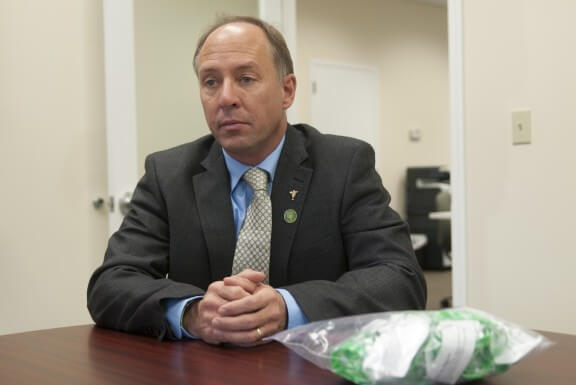 Zena, 24, is undergoing leech therapy for her fertility issues.
Zena, 24, is undergoing leech therapy for her fertility issues.
Credit: Bess Adler / Metro
At a medical office near Bensonhurst, Brooklyn, a 24-year-old woman prepared to get her blood sucked.
Zena, who asked to be identified by her nickname for privacy, has been trying to get pregnant for three years. The Brooklyn resident tried intrauterine insemination, Clomid and other medications without success, so she did what most people do when faced with a medical dilemma: She turned to Google. There, she found information on leech therapy, also known as hirudotherapy, as a fertility treatment.
This was Zena’s third treatment in two weeks. OB-GYN Viktoriya Bakcheva, M.D. and D.O., reached her gloved hands into a large glass jar filled with water – and leeches. She used cotton pads to place the squirming black worms onto Zena’s stomach until they attached and formed tiny Os with their mouths. The little lines on their bodies waved in barely perceptible undulations as they curled up like fortune cookies on Zena’s skin.
“Just breathe,” Bakcheva commanded. “Breathe easy.”
Bakcheva’s colleague and former teacher, Alicja Kolyszko, peered over glasses perched on the tip of her nose. She explained that leeches increase blood circulation and microcirculation and detoxify the liver. “You have to include the liver,” she said.
Kolyszko added that leech saliva, which contains anticoagulant enzymes and improves blood flow, is crucial. “The secret is what the leeches put into the body,” she said.
 Leeches swim in a glass jar, awaiting their turn to suck blood out of a patient.
Leeches swim in a glass jar, awaiting their turn to suck blood out of a patient.
Credit: Bess Adler / Metro
Zena, for her part, stayed calm. “I don’t feel scared,” she said. “I don’t feel anything.” She did admit that it tingled a bit, but said it was completely painless. Surprisingly, she said her first treatment, which involved leeches on her genital area, was the most comfortable.
Kolyszko is from Poland and Bakcheva hails from Russia, so the two women grew up in countries where no one bats an eyelash at leech therapy. Leech treatment may seem like it belongs to the Old World, but Kolyszko insists that there’s nothing outdated about leech therapy.
Not everyone agrees. Dr. Houman Danesh, director of integrative pain management at Mount Sinai Hospital, said he would not recommend leeches except for the purpose of increasing blood flow to a particular area. “I think it’s on the outskirts of medicine,” he said. “I wouldn’t say it’s completely insane, especially because they have leeches at hospital institutions … but there aren’t really good studies out there.”
Tell that to Kolyszko, who has spent the last 14 years practicing and teaching leech therapy at her school, the Academy of Hirudotherapy. She is a mother hen to 30 leech therapists in North America and constantly travels to visit her graduates. “I’m a vagabond,” she said, waving her hand as her teased blonde bun bounced in kind. “A gypsy. I travel everywhere.”
For the past six to seven years, she has spent most of her time in New York; eight of her graduates are in the New York metropolitan area and she is training another one in Brighton Beach.
Kolyszko’s students become Certified Hirudotherapy Practitioners by studying and training hands-on with her for over 1,000 hours. Kolyszko herself received training in Poland, Russia and the U.K. Kolyszko and her disciples use leeches to treat everything from cardiovascular disease to aging skin.
She said it is extremely important for leech therapists to receive proper training. “Especially people from Eastern Europe do home therapy,” said Kolyszko. “It could be tragic. They could have a hemorrhage.” Kolyszko and her graduates only use Hirudo medicinalis leeches from an FDA-approved distributor in North Carolina.
After getting its fill and seemingly doubling in size with blood, a single leech rolled off Zena’s abdomen. Bakcheva picked it up and promptly dropped it into a Biohazard container. She then doused it in alcohol to kill it.
“One-time use only,” said Kolyszko. “Bacteria can stay in the leeches.”
As her session wrapped up, Bakcheva removed the remaining leeches and wrapped Zena’s stomach, which oozed only slightly with blood, with a diaper and tape.
“I feel funny,” said Zena as she got up to leave. When asked if she was in pain or felt uncomfortable, she responded with a simple, “No.” She then pointed to the padding around her stomach. “I mean I feel fat and funny.” She giggled and got her coat to meet her husband and go home.
Kolyszko showed a photo of the discharge that can come from a leech therapy session – much of it seeps out over a period of one to two days after the treatment. In the photo, the patient’s body looked like its was covered in blood. Kolyszko explained that the discharge was a combination of blood clots and toxins expelled from the body.
She offered to let me experience a treatment. When I responded that I would be open to trying it for a few minutes just to see what it would feel like, Bakcheva looked thoroughly offended. “This is humiliating for the leech,” she said, her gray-green eyes widening.
Kolyszko explained that the one-time use nature of the leech rendered “trying” a leech disrespectful. I apologized and declined to undergo treatment.
Bakcheva said, “I tell my patients, ‘Say “thank you” to every leech. She sacrificed her life for you.'”
Follow Andrea Park on Twitter: @andreapark


















